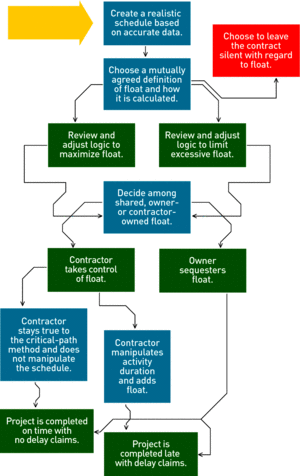

We live in a new era of construction cooperation. When it comes to project float, sharing it between the contractor and owner is in, while exclusive float ownership by either party is out.
Although float is generally understood in the industry as extra time or leeway for completing a project schedule, its use remains controversial. At stake in the float debate are hundreds of millions of dollars lost or won in timely completions or delays. Some fervently support float sharing, believing it epitomizes fairness and harmony.
Others say float calculations are fraught with deception. Even if calculated honestly, float rightfully belongs to the owner or contractor for their exclusive benefit.
No wonder some contractors seem to be of two minds about the situation. "In the best of all possible worlds, if we were only looking out for ourselves, we would want to own the float," says Ronald Cortes, a vice president of Pittsburgh-based Mascaro Construction Co., a general contractor. "But we have to look out for our clients."
With some notable exceptions, contracts and U.S. courts that take up the issue of float are most likely to treat it as a shared resource. Federal contracting boards of appeal support shared float, and standard contract agreements used by the California Dept. of Transportation use a version of sharing. While courts in England haven't dealt directly with float ownership, the delay protocol used by England's Society of Construction Law suggests that, generally, the project owns the float.
And as one consultant put it, judges have shown a tendency to support sharing for the good of the project, probably because it emphasizes the civic, public character of construction.
Even James J. O'Brien, a pioneer in the critical-path method, blessed the shared-resource approach in his 1993 book, "CPM in Construction Management."
But 18 years later, not everybody thinks the shared approach is a Shangri-La for construction.
Stephen A. Hess, an attorney with Sherman & Howard LLC in Colorado, subjected the shared-resource rule to a withering critique last year in the winter issue of the Journal of the American College of Construction Lawyers.
Sharing of float is rarely clear in case law regarding contracts, Hess argues, and it harms contractors in significant ways. By depriving contractors of use and control of the schedule they create and execute in carrying out the work, float-sharing cuts the connection between risk, responsibility and control. If timely completion resides in the contractor's domain, Hess claims, control of time belongs there, too.
Float can lead to other problems. Under most shared-resource contract clauses, the first party to need the extra time is permitted to use it. But to Hess, "first come, first served" doesn't seem like a good idea. With much of the owner's design work and preparation taking up time at the start of a project, sharing disproportionately helps the owner; if contractors run into problems later in the work, all or some of the float may have been burned already.
"I never liked the [shared-resource rule] because it assigns pretty important economic ramifications to chance," Hess said in an interview with ENR. It's like using "a chainsaw to do surgery."
The controversy comes at an opportune time. An associate professor of civil engineering at the Catholic University of America in Washington, D.C., Gunnar Lucko is launching a study of risk management as applied to critical-path method (CPM) scheduling. Contractors and CPM experts tell ENR that despite the predominance of the shared-resource rule, contracts and state courts are all over the map on the issue and that float treatment is far from a settled matter.
Presumably Lucko will try to sort out the existential problem that Hess sees: Does float exist if there is no CPM schedule? And if it does, who should use it?
Little is simple when it comes to CPM, and a lot depends on the questions you ask.


Post a comment to this article
Report Abusive Comment